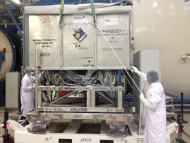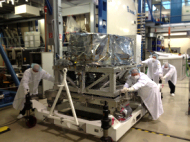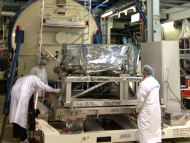#02: NIRSpec's European adventure
7 August 2013
In this second entry of the JWST MIRI and NIRSpec integration and test journal, we catch up with NIRSpec - the Near InfraRed Spectrograph, before it departs Europe for NASA's Goddard Space Flight Center (GSFC). NIRSpec is an instrument provided by ESA for the NASA-ESA-CSA James Webb Space Telescope (JWST).| Video of NIRSpec acoustic and vibration testing, June 2013. Credit: EADS Astrium. (Click here for further details and larger versions of this video.) |
The NIRSpec flight model's path to qualification and delivery has not always been smooth: in August 2011, inspection of the optical bench at EADS Astrium GmbH revealed three very thin cracks in the Silicon Carbide ceramic optical bench. These tiny cracks originated in bolt holes which are used to attach the corner posts of the instrument cover. After further investigations, redesign of all the relevant bolted interfaces, re-qualification tests and the revision of some integration procedures, all NIRSpec sub-systems were disassembled from the damaged optical bench and, in November 2012, re-integrated and aligned to the carefully screened flight spare optical bench, getting NIRSpec back on track.
Once the integration was complete, NIRSpec was packed and, in December 2012, moved the 500m to the IABG test facility for cryogenic and vacuum testing.
The instrument was installed in a vacuum test chamber and, over a few days, it was cooled down to its operating temperature of close to -233 degrees Celsius - mimicking the conditions it will encounter in space. These conditions were maintained for almost a month, while engineers and scientists tested the instrument to obtain key characterization and calibration data. The instrument was then warmed up to room temperature and air was allowed back into the chamber.
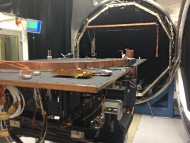 |
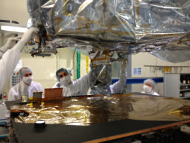 |
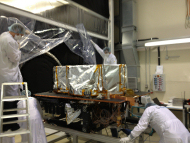 |
| Left to right: IABG cryogenic test chamber and support table; Installing NIRSpec onto the cryogenic test chamber support table; Moving NIRSpec into the cryogenic test chamber. |
||
In February this year, NIRSpec was returned to the cleanroom at Astrium, where it was inspected to ensure that there had been no damage or changes in alignment during transport and testing.
The next step was the replacement of some hardware components. To enhance the performance of the instrument the optical bench kinematic mounts and a re-designed straylight baffle were successfully exchanged on the flight model.
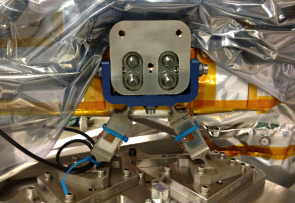 |
| JWST's NIRSpec kinematic mounts. Credit: EADS Astrium |
The kinematic mounts are the three "feet" of NIRSpec. They will attach to the integrated science instrument module (ISIM) structure of the JWST payload module. These feet have some flexibility, and ensure NIRSpec remains correctly aligned with the telescope, while still allowing for small movements resulting from the cool down and gravity release. The feet also support the 200kg instrument during the vibration of the launch. The original feet were replaced with a more robust set.
To stop stray light reflecting off the instrument and giving false measurements, an optically opaque baffle is required. During launch, very strong sound waves propagate within the instrument, and although the original baffle worked well in terms of stopping stray light, studies showed that NIRSpec's micro-shutter assembly (a novel micro electro-mechanical system which holds about a quarter of a million small shutters that can all individually be addressed to select scientific targets) was very sensitive to the pressure differences across the baffle. A new baffle, which incorporates a labyrinth of openings to allow the passage of air during launch and depressurization, was manufactured and installed.
The next tests, performed at Astrium, were to simulate the vibration and sounds that will be experienced by the instruments during the launch of JWST onboard an Ariane 5. These acoustic and vibration tests were carried out over a period of about three weeks and were successfully completed at IABG in the second half of June, 2013.
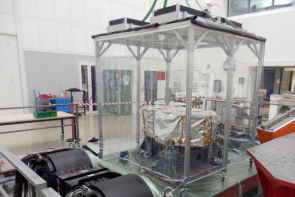 |
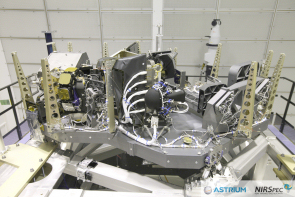 |
| NIRSpec acoustic and vibration testing, June 2013. Credit: EADS Astrium | JWST's Near InfraRed Spectrograph (NIRSpec), July 2013. Credit: EADS Astrium |
Post test alignment checks were then completed in Astrium's cleanroom and, following confirmation that the instrument alignment remained within specifications, NIRSpec was packed and moved back to IABG where it is currently installed in the cryogenic chamber for a second short cryo-vacuum test campaign. The instrument was cooled-down and reached operating temperature by the end of July and is now ready for testing.
After these tests, NIRSpec will be returned to Astrium for final alignment and functional testing. NIRSpec will then be delivered to ESA and shipped to NASA's Goddard Space Flight Center (GSFC), where it will join MIRI in the Space Systems Development and Integration Facility (SSDIF) - the largest 'class 10 000' cleanroom facility in the world - for integration into JWST.
About JWST
The James Webb Space Telescope (JWST) will be a general-purpose observatory with a 6.5-m telescope optimised for infrared observations and a suite of 4 astronomical instruments capable of addressing many of the outstanding issues in astronomy. The primary aim is to examine the first light in the Universe - those objects which formed shortly after the Big Bang. Further aims include: looking at how galaxies form; the birth of stars; and the search for protoplanetary systems and the origin of life, including the study of exoplanets. JWST is a joint project of NASA, ESA and the Canadian Space Agency. It is scheduled for launch in 2018 by an Ariane 5 and will operate approximately 1.5 million kilometres from the Earth in an orbit around the second Lagrange point of the Sun-Earth system, L2.
About NIRSpec
The Near InfraRed Spectrograph (NIRSpec) is one of four instruments on JWST. NIRSpec is a multi-object spectrograph capable of observing more than 100 astronomical objects simultaneously. It will support JWST's four main science themes by providing low, medium and high-resolution spectroscopic observations.
NIRSpec is built by European industry to ESA's specifications and managed by the ESA JWST Project at ESTEC, the Netherlands. The prime contractor is EADS Astrium GmbH in Ottobrunn, Germany. The NIRSpec detector and MSA subsystems are provided by NASA's Goddard Space Flight Center.

